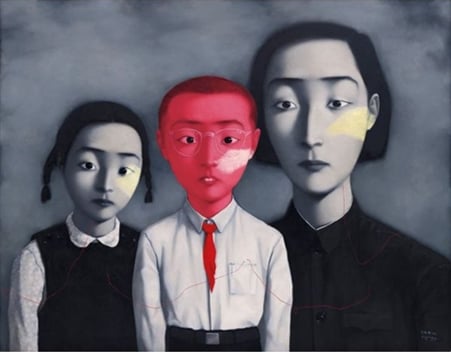Galleries
Zhang Xiaogang Artist Index and the Bloodlines Series
Break down the success of Bloodlines using artnet Indices.

Break down the success of Bloodlines using artnet Indices.

Katherine Markley

In 2003, A big family series, from Zhang Xiaogang’s Bloodlines series, sold at Christie’s Hong Kong for US$76,000. Despite the fact that he had several extremely successful gallery shows two years earlier, in 2003, Zhang had little presence in the secondary market, with only four lots selling at auction. This sale marked the beginning of Zhang’s prominence at auction, which has made him the most expensive living painter among Chinese artists. This same lot has been sold twice since its auction debut, selling for US$1.4 million at Christie’s London in 2006, and again for US$7.3 million at Sotheby’s Hong Kong in 2011. In a span of only eight years, A big family series earned a return just shy of 10,000 percent, outperforming overall returns at auction for the artist as a whole, as well as the overall Contemporary market during the same time period.

Zhang Xiaogang, Bloodline-big family, 1995
How does one’s work consistently perform so well at auction, and to what can we attribute this success? Dealers, auction house specialists, collectors, and artists will give you a variety of answers, but with artnet Analytics, we can pinpoint and quantify the effect of certain characteristics that contribute to this specific phenomenon. The painting in question, A big family series, is immediately recognizable as part of Zhang’s most prominent series, Bloodlines. This series accounts for roughly one third of the paintings the artist has created to date, and these works vary in subject matter and date range. This specific work was executed in 1995, and belongs to the earlier subset of works in this series.
Using indices, we can compare different iterations of Zhang’s Bloodlines series against his overall market, or against other financial and art market indices. While Zhang’s overall index has outperformed the SSE Composite Index since 2004, works in the series have proven to be a consistent and stable source of high returns when sold at auction.
2011 was a strong year for Zhang’s market; 86% of his lots sold at auction, with an average sale price of US$1.5 million. Three of his Top 5 prices achieved sold in 2011, with two of these works belonging to the Bloodlines series.
While much of Zhang’s work focuses on the aftermath of China’s Cultural Revolution, and the shifting perception of family, history, and memory in China today, these sentiments are acutely present in his Bloodlines series. Driven by his desire to capture and recontextualize these forgotten histories, Zhang began painting his series in the early 1990s, after finding a box of old family photographs in his parents’ house. Struck by the unfamiliar images of his parents’ faces, Zhang embarked on these works by analyzing various family structures in formats resembling old and faded photographs.
The earliest works in this series were quickly picked up by Zhang’s dealer in Hong Kong, and caught the eye of one of his most prominent collectors, the former Swiss Ambassador Uli Sigg, who immediately commissioned a work from this series to display to guests in his home. In 1995, Zhang was invited to the Venice Biennale to exhibit a work from Bloodlines. At this time, the artist reached international recognition as one of the new faces of Chinese painting. His reputation and the prominence of this series continued to gain acclaim in the following years; he was the subject of several major exhibitions worldwide. By 2001, his work was introduced to the auction market with the sale of Recall from the past for US$5,355 at Christie’s Taipei.
His early Bloodlines works, painted in the 1990s, were the obvious pioneers at auction, gaining traction quickly and moving into six-figure estimates within three years. The work we are analyzing, A big family series, exemplifies the success of the these early works. Below, works from the early and late periods of the series are compared against each other over the past eight years.
Since 2005, the earliest Bloodlines works created have outperformed works created in the 2000s, with Bloodline: Big Family No. 1 (1994) and Bloodline-Big Family (1995) selling in 2011 for US$8.4 million and US$7.2 million, respectively, at Sotheby’s Hong Kong. Both works mentioned above are among the artist’s Top 5 prices achieved at auction.
Works from the series can also be further broken down into single portraits of family members, parent and child pairs, and big family portraits. A breakdown of the series by subject matter is detailed in the graph below, with works portraying big families outperforming works depicting pairs and single portraits.
Bloodlines works depicting big families and pairs consistently sell better than portraits from the same series at auction, earning stronger returns. Portraits achieved an overall sell-through rate of only 63%, while works depicting families and pairs attained 70 to 75% sell-through rates. Higher demand for big families has led to aggressive bidding and several headline sales for works in this series, including the sale of A big family series for US$7.2 million in 2011.
By analyzing the performance of specific series within Zhang’s market, it is possible to break apart several factors that may have contributed to the auction success of the 1995 Bloodlines work, A big family series. While degrees of artistic merit and external factors will always compound market forces, it is helpful to be able to quantify the impact specific attributes have in terms of overall performance. Buyers and sellers can get a closer look at the market by analyzing the specific series or movement to which a work belongs.
For more information about the methodology of artnet Indices, please see the artnet Analytics White Paper.
Need additional analysis? artnet Analytics can work with you to create even more customized reports based on the specific needs of your auction house.